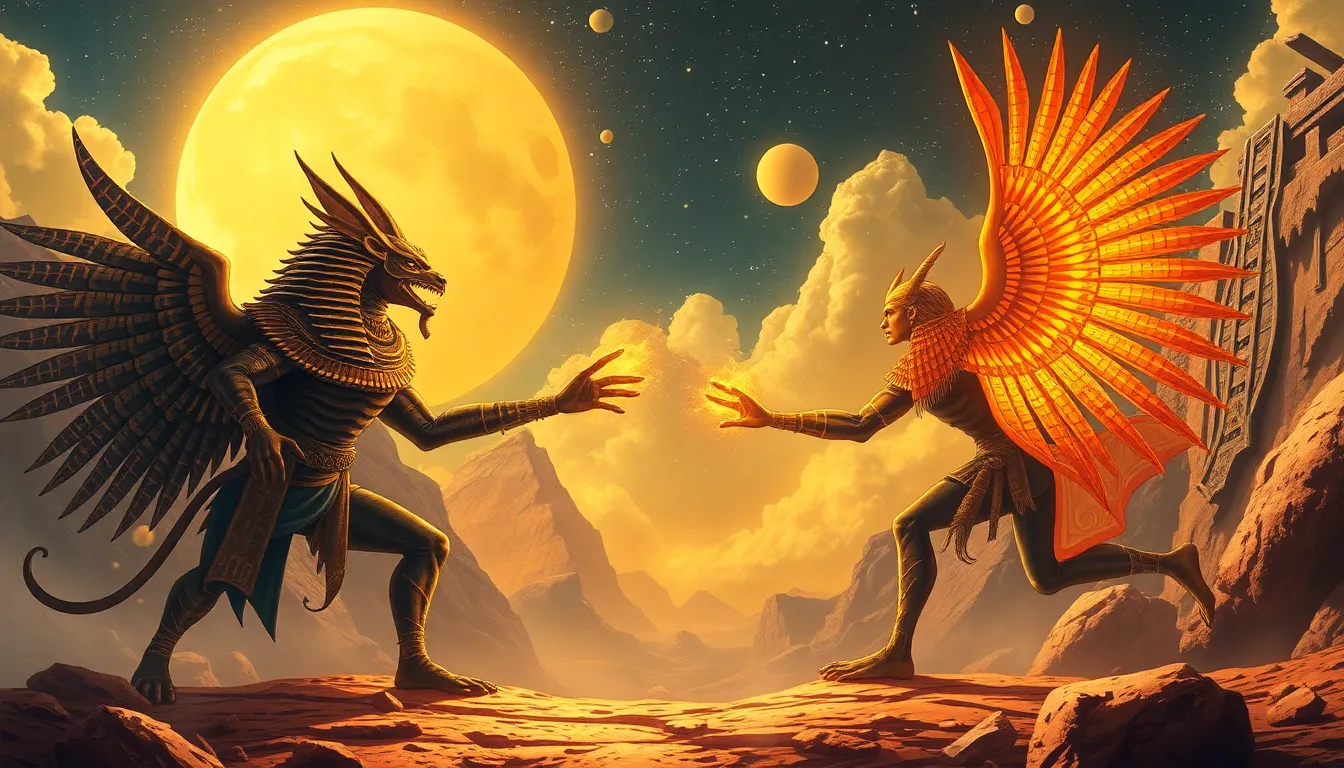The Myth of the Celestial Battle: Ra and Apep
I. Introduction
Egyptian mythology is a rich tapestry of deities, creation myths, and moral tales that have fascinated scholars and enthusiasts for centuries. Among these myths, the struggle between the sun god Ra and the serpent Apep stands out as a powerful narrative illustrating the eternal conflict between order and chaos. This article aims to explore the intricacies of this myth, its characters, and its broader implications for ancient Egyptian culture and beyond.
II. The Characters of the Myth
A. Ra: The Sun God
Ra, often depicted with a falcon head and a solar disk, is one of the most important deities in Egyptian mythology. He is revered as the god of the sun and is associated with creation, life, and growth.
- Attributes and symbolism: Ra embodies the sun’s life-giving energy and is often associated with warmth, light, and creation.
- Role in creation and the daily cycle: According to myth, Ra created himself from the primordial waters of chaos, and every day, he travels across the sky in his solar boat, bringing light to the world.
B. Apep: The Serpent of Chaos
Apep, also known as Apophis, is the embodiment of chaos and darkness. He is often represented as a massive serpent or dragon, symbolizing the dangers that threaten the order of the universe.
- Characteristics and symbolism: Apep is the antithesis of Ra, representing all that is evil and destructive in the world.
- Representation of chaos and darkness: Apep’s existence signifies the ever-present threat of disorder, lurking in the shadows, ready to consume the light.
III. The Celestial Battle: A Narrative Overview
A. Description of the battle between Ra and Apep
The celestial battle between Ra and Apep takes place each night as Ra journeys through the underworld on his solar barque. This journey symbolizes the struggle between light and darkness.
B. Key events during the nightly journey of Ra
As Ra moves through the darkness, he encounters Apep, who attempts to stop him and plunge the world into chaos. The battle is fierce, involving:
- Ra’s fierce warriors, who assist him in fighting Apep.
- Magical spells and incantations invoked by Ra to protect himself and maintain order.
- Allies such as the goddess Isis and other deities who join the fight against Apep.
C. The significance of the battle in the myth
This nightly battle serves as a metaphor for the perpetual struggle between good and evil, order and chaos. Ra’s triumph over Apep ensures that the sun rises again each day, symbolizing hope and renewal.
IV. Symbolism and Themes in the Myth
A. Light versus darkness
The battle between Ra and Apep is a vivid representation of the conflict between light and darkness. Ra’s light represents knowledge, truth, and life, while Apep embodies ignorance, destruction, and death.
B. Order versus chaos
This myth encapsulates the Egyptian worldview that order (Maat) must be maintained against the forces of chaos. The struggle symbolizes the necessity of balance in the universe.
C. The cyclical nature of life and death
The daily journey of Ra reflects the cyclical nature of existence—birth, death, and rebirth. Just as Ra must die each night and be reborn each morning, so too does life follow this cycle.
V. Cultural and Religious Significance
A. Worship practices related to Ra and Apep
Ancient Egyptians engaged in various rituals and prayers to honor Ra, seeking his favor for a prosperous life. Apep, on the other hand, was often invoked in protective rites to ward off chaos.
B. The impact of the myth on ancient Egyptian society
The myth of Ra and Apep influenced moral teachings and social order. It reinforced the importance of harmony and the consequences of chaos in society.
C. Interpretation in art and literature
The battle between Ra and Apep has been depicted in numerous artifacts, including:
- Wall paintings in tombs and temples.
- Sculptures and carvings showcasing scenes of their conflict.
- Literary texts that recount the story and its implications.
VI. Modern Interpretations and Misunderstandings
A. Common misconceptions about the myth
Many modern interpretations simplify the myth, reducing Apep to a mere villain without recognizing the deeper themes of chaos and order that are integral to the narrative.
B. Influence of the myth on contemporary culture
The themes of the Ra and Apep myth resonate in modern storytelling, influencing movies, literature, and art that explore the battle between good and evil.
C. Reinterpretations in modern storytelling
Contemporary works often reinterpret the myth, using its rich symbolism to address modern issues such as environmentalism, the struggle for justice, and the quest for balance in life.
VII. The Legacy of Ra and Apep
A. Enduring themes in modern mythology
The themes of the celestial battle continue to resonate, reflecting humanity’s ongoing struggles against chaos and the pursuit of harmony.
B. The relevance of the myth in today’s world
In a world rife with conflict and uncertainty, the myth of Ra and Apep serves as a reminder of the importance of resilience, hope, and the eternal struggle for balance.
C. Lessons learned from the celestial battle
The myth teaches valuable lessons about the nature of existence, the cyclicality of life, and the necessity of confronting chaos to maintain order and harmony.
VIII. Conclusion
In conclusion, the myth of Ra and Apep is not only a captivating story of conflict but also a profound narrative that reflects fundamental truths about human existence. The ongoing battle between light and darkness, order and chaos, serves as a timeless reminder of the resilience of life and the importance of balance in our world. Understanding such myths enriches our comprehension of human culture and the narratives that shape our lives.




